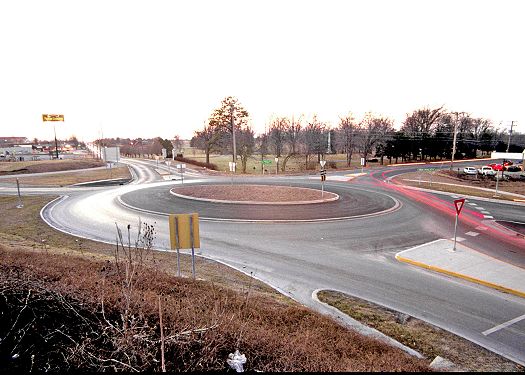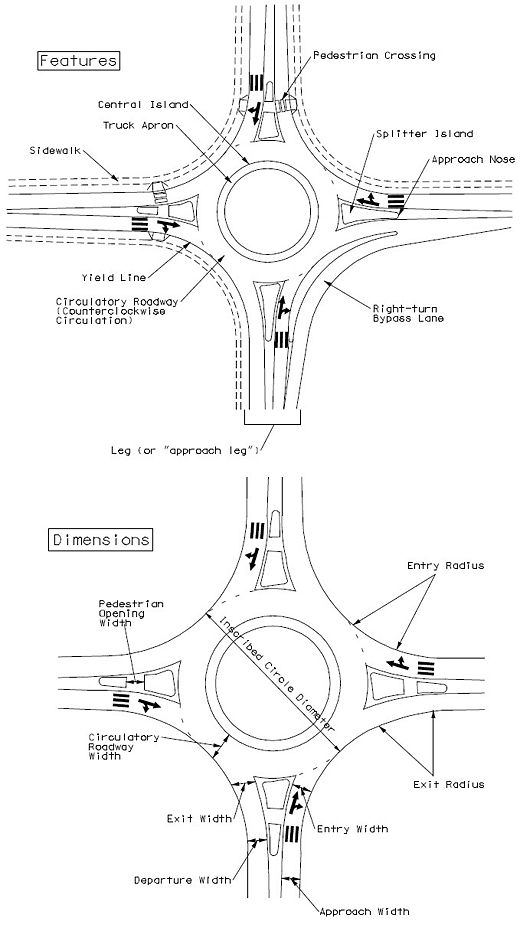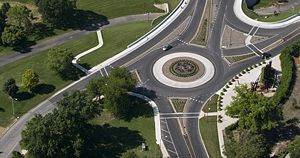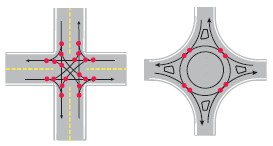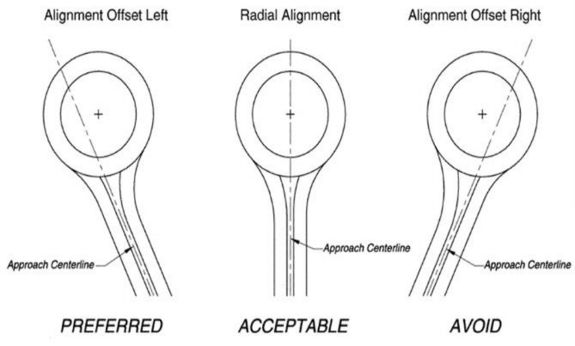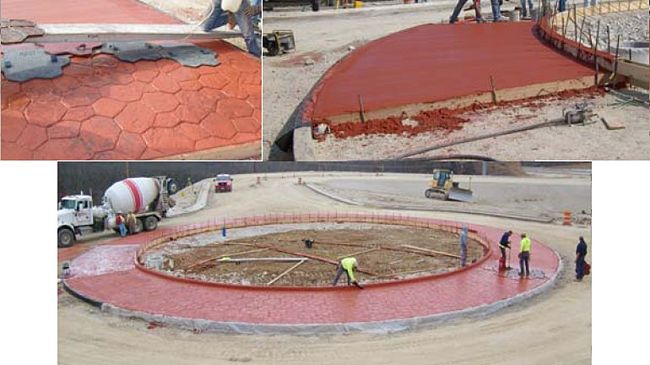Difference between revisions of "233.3 Roundabouts"
m (Added a video) |
m (link to FHWA roundabout video added) |
||
| Line 26: | Line 26: | ||
|colspan="2"|<center>[[Media:131.4 DESIGN EXCEPTION INFORMATION FORM.doc|Design Exception Information Form]]</center> | |colspan="2"|<center>[[Media:131.4 DESIGN EXCEPTION INFORMATION FORM.doc|Design Exception Information Form]]</center> | ||
|- | |- | ||
| − | |colspan="2"|<center>''' | + | |colspan="2"|<center>'''Videos'''</center> |
|- | |- | ||
|colspan="2"|<center>[[media:233.3 All About A Roundabout.wmv|All About A Roundabout]]</center> | |colspan="2"|<center>[[media:233.3 All About A Roundabout.wmv|All About A Roundabout]]</center> | ||
| + | |- | ||
| + | |colspan="2"|<center>An FHWA video, [http://safety.fhwa.dot.gov/intersection/roundabouts/#video Modern Roundabouts: A Safer Choice] is also available. | ||
|} | |} | ||
Revision as of 14:08, 17 August 2010
A roundabout is a circular traffic intersection featuring yield control on all entering roadway legs, one-way continuous flow within the circulatory roadway, channelization of the approaching roadways, and appropriate geometric curvature to keep circulating speeds low. Roundabouts may contain as few as three legs; however, roundabouts with more than four legs are not uncommon. Typical roundabout terminology with key geometric elements is available.
This article does not present a comprehensive procedure for roundabout design, but are intended to provide guidance related to key design parameters. Other publications, such as FHWA’s publication, Roundabouts: An Informational Guide, may be referred to as needed. Where specific guidance on design elements is not given in this article, standard MoDOT intersection design practices will be used.
Certain roundabout characteristics can vary depending on the nature of the roundabout’s location (ie. urban or rural). Where these variations are noteworthy, they are described in detail in the following material.
Contents
- 1 233.3.1 Single-Lane Roundabouts
- 1.1 233.3.1.1 Justification for Use
- 1.2 233.3.1.2 Operational/capacity analysis
- 1.3 233.3.1.3 Design criteria
- 1.4 233.3.1.4 Sight Distance
- 1.5 233.3.1.5 Central Island
- 1.6 233.3.1.6 Truck Apron
- 1.7 233.3.1.7 Circular Roadway
- 1.8 233.3.1.8 Splitter Islands
- 1.9 233.3.1.9 Approach Roadway
- 1.10 233.3.1.10 Bypass Lanes
- 1.11 233.3.1.11 Bicycles and Pedestrians
- 1.12 233.3.1.12 Other Issues
- 1.13 233.3.1.13 Signing and Pavement Marking
- 1.14 233.3.1.14 Landscaping, Lighting and Drainage
- 1.15 233.3.1.15 Traffic Control During Construction
- 2 233.3.2 Multi-lane Roundabouts
- 3 233.3.3 Deflection
233.3.1 Single-Lane Roundabouts
233.3.1.1 Justification for Use
The process of selecting a roundabout as the preferred form of traffic control for a given intersection has three stages. If a roundabout is not “preferred” at any one of these stages, it will cease to be considered as a viable form of traffic control at the given location.
Stage 1: Appropriateness. The initial stage involves a “broad brush” determination of whether the site is appropriate for a roundabout. Guidance about potentially appropriate and inappropriate sites for the use of roundabouts is available. The site-specific conditions are to be compared to those in the table to determine whether a roundabout merits further consideration.
Stage 2: Operational Feasibility. Once a roundabout is determined to be a potentially appropriate form of traffic control, the second stage involves testing to determine if a roundabout can function at an acceptable level of service. A capacity analysis is performed to determine volume-to-capacity (v/c) ratio and basic lane needs. This analysis is based on peak-hour volumes appropriate for local conditions. The analysis is conducted for both Construction Year and Design Year traffic volumes.
Stage 3: Comparative Performance. Once it is determined a roundabout can function at an acceptable level of service, the final stage compares it’s performance to the performance of other potential forms of traffic control (such as signalization) at the given location. The comparison may include, but should not necessarily be limited to: operational performance, construction cost, life-cycle cost, right of way considerations, “reserve capacity” (the ability to accommodate traffic growth), and constructability.
The justification procedure for each roundabout will be documented in a memorandum describing the results of the analysis described performed in the three stages. This memorandum will also summarize the reasons a roundabout was selected as the method of traffic control. The memorandum will be included in the projects conceptual report.
233.3.1.2 Operational/capacity analysis
The capacity model described in the Highway Capacity Manual (HCM) will be used as the primary check of a roundabout’s capacity. The HCM model applies only to single-lane roundabouts. The model is fundamentally based on gap-acceptance theory. Capacity values are developed for each approach based on peak-hour circulating volumes. Roundabouts will be designed to operate at no more than 85% of capacity. This concept is known as “practical capacity.”
Additional analysis is performed to refine the geometric design and provide more information for Stage 1 and 2 of the justification procedure. Operational analysis will use the SIDRA software package. If simulation is desired, the VISSIM software package will be used.
233.3.1.3 Design criteria
Three fundamental considerations in roundabout design are design speed, capacity, and design vehicle. These parameters result in a series of tradeoffs; while large-diameter roundabouts may provide higher capacity and better truck accommodation, they tend to reduce safety through higher operating speeds. Typical dimensions for a standard four-leg roundabout that satisfies fundamental design criteria are available.
A maximum operating speed of 25 mph should be used. A typical range of 18 to 22 mph is desirable. Speed control at roundabouts is primarily achieved through the deflection of entering vehicles. Operating speeds should be calculated on a move-by-move basis, by drawing the fastest path allowed by the roundabout geometry. The designer develops a speed matrix to illustrate that all speeds have been checked and that operating speeds do not exceed the maximum.
The design of all roundabouts will accommodate a WB-67 design vehicle. In order to keep operating speeds below the allowable maximum, a truck apron may be provided.
Emergency vehicles can generally be accommodated at roundabouts that have been designed for WB-67 design vehicles. Turning paths are checked using AutoTurn software for all allowed movements from each approach, to verify the design vehicle and emergency vehicles can be accommodated.
Transit stops are not to be placed within roundabouts. Transit stops located near roundabouts will include bus turnouts to promote traffic flow and increase safety.
233.3.1.4 Sight Distance
Two categories of sight distance are examined at roundabouts; stopping sight distance and intersection sight distance.
At a minimum, three types of stopping sight distance are checked; approach, circulatory and exit/pedestrian. Methods to measure these values are available. Sight distances are based on a driver eye height of 3.5 ft. and an object height of 2.0 ft.
Two types of intersection sight distance are measured; adjacent entry and circulatory. Methods used to measure these values are also available. Sight distances are based on a driver eye height of 3.5 ft. and an object height of 3.5 ft.
233.3.1.5 Central Island
The central island will be separated from the truck apron by a 6 in. barrier curb. The central island is typically circular in shape. In certain situations, non-circular shapes such as ovals or ellipses can be used. These shapes can be justified for use if irregular approach geometry or an odd number of approaching roadways are at the site. The design of the central island is governed by the operating speed and the design vehicle for the roundabout.
233.3.1.6 Truck Apron
A truck apron is a raised mountable portion of the central island that provides additional circulatory width for large vehicles. A truck apron is to be provided when the central island geometry, as designed to maintain low circulatory speeds, impedes circulation of the design vehicle.
The truck apron is separated from the circulatory roadway by a three-inch mountable curb. The width of the truck apron is the minimum necessary to accommodate the design vehicle. An overly wide apron can confuse drivers by creating a distorted sense of proportion. The width of a typical truck apron is 10 ft.
The truck apron will visually contrast with the circulating roadway. This will delineate the truck apron and discourage motorists from driving on it.
233.3.1.7 Circular Roadway
The width of the circulatory roadway will be the minimum necessary to accommodate the design vehicle. It is equal to the difference between the inscribed circle radius and the central island/truck apron radius. Parking or stopping in the circulatory roadway is prohibited. The outer edge of the circulatory roadway will be a barrier curb (except at openings for entry and exit legs).
233.3.1.8 Splitter Islands
Splitter islands serve two primary functions at a roundabout; physical separation of entering and exiting traffic (consequently reinforcing one-way circulation), and deflection of entering traffic (to control entering speeds). In addition, a splitter island can serve as a pedestrian refuge. Splitter islands will include a barrier curb.
The splitter island geometry is typically asymmetrical. Generally, the entry side provides deflection to slow speeds, while the exit side provides a larger opening to facilitate egress.
The minimum width of a splitter island without a pedestrian crossing is 4 ft.; with a pedestrian crossing, the minimum width (at the crossing) is 6 ft. The pedestrian opening will be 10 ft. wide.
233.3.1.9 Approach Roadway
On approach roadways with a wide median or a two-way left-turn lane (TWLTL), a narrowing of the existing median, to match the splitter island dimensions discussed above, will generally be needed in order to achieve the necessary entry deflection.
Approach roadway legs will include a barrier curb (on the right side) for at least half the length of the splitter island. A typical entry width is 16 ft. (measured curbface to curbface) to allow traffic to bypass a stalled vehicle. The turning path of the design vehicle controls the exit width. A typical exit width is 18 ft.
233.3.1.10 Bypass Lanes
Right-turn “bypass lanes”, channelized so vehicles do not enter the roundabout, may be considered on approach roadway legs. Bypass lanes are to be avoided where moderate to high pedestrian or bicycle volumes are anticipated. Pedestrian crossings are discouraged across bypass lanes. Potential applications for which bypass lanes are to be considered (this list is not exhaustive) are:
- To reduce the number of vehicles entering the roundabout
- If right turns compose more than half of the entry volume, or
- If the right-turn volume exceeds 300 vehicles during a single hour
- To resolve geometric difficulties
- An approach with two existing lanes intersecting a roundabout at which only one circulating lane is needed
- An acute angle between adjacent legs
The use of a bypass lane must account for potential weaving and merging needs of traffic. The presence of closely spaced intersections, nearby driveways, and “entrapment” lanes can negatively affect bypass lane operations. These concerns must be thoroughly examined before a bypass lane is included as part of a roundabout.
233.3.1.11 Bicycles and Pedestrians
Bicycle facilities or markings are not provided within the circulating roadway or the central island. If bike lanes are provided on the intersecting roadways, they should be transitioned to off-street facilities sufficiently in advance of the roundabout to avoid introducing additional driver decision points in the roundabout. Bicyclists may choose to enter the roundabout as a vehicle (using the circulatory roadway) or, they may use multi-use facilities if they are provided. Potential bicycle-lane treatments, including bicycle ramps and bicycle platforms are available.
The design of a roundabout will not encourage pedestrian movement within the circulatory roadway or the central island. If crosswalks are determined to be necessary, they are typically located approximately one vehicle length behind the yield line (to allow a pedestrian to cross behind a stopped vehicle), unless it is determined a larger distance is needed to prevent exit queues from backing into the circulatory roadway. Even if sidewalks are not provided, curb cuts and splitter island openings will still be provided at the typical locations in anticipation of future crosswalks. In all cases, pedestrian-related design will conform to the requirements of the Americans with Disabilities Act (ADA).
233.3.1.12 Other Issues
Dropping a lane approaching a roundabout is not typical within a distance less than 200 ft., as measured from the downstream end of the lane drop taper.
Ideally, the angles between all adjacent roundabout legs are equal (for example, 90° on a 4-leg roundabout). Maximizing the spacing between legs promotes smooth traffic flow. The designer should attempt to space the approaches so the distance between the extended centerlines of the entry lanes of any two adjacent approaches, measured along the centerline of the circulatory roadway, is at least 50 ft. If reasonable spacing cannot be achieved, careful design consideration is needed to optimize operational characteristics.
Ideally, roundabouts are constructed at level intersections. The maximum approach grade to roundabout is 3%.
It is desirable to provide a -2% cross slope (away from the central island) on the circulatory roadway. A -4% (away from the central island) cross slope on the truck apron is preferred.
233.3.1.13 Signing and Pavement Marking
Typical signing and pavement marking for a roundabout are available. There are three classes of signs that are used in a roundabout. They are:
Pavement markings are provided in three areas of the roundabout. They are:
- Circulatory roadway
- Approach legs
- Pedestrian crossings
Specific signing and pavement marking details are also available.
233.3.1.14 Landscaping, Lighting and Drainage
Any landscaping of the roundabout will be located so it does not obstruct sight distance. However, it is generally a good idea to locate landscaping in the center of the central island to create a visible, vertical obstruction that can be seen well in advance. This has the added effect of blocking views between opposing approaches. Landscaping will not attract pedestrians to the center of the roundabout – in fact, low landscaping can be used on the outside of the roundabout (between the sidewalk and the curb) to provide a physical barrier to direct pedestrians toward the crosswalks. The splitter islands are not to be landscaped. Landscaping will not introduce any hazards to the intersection.
Landscaping will be designed for minimal maintenance. If vegetation within the roundabout requires watering, a sprinkler system will be installed.
Lighting intensities at roundabouts will generally conform to MoDOT guidelines for intersection lighting. Key locations to be lit include the splitter island approach noses, all conflict areas where traffic enters the roundabout, and all places where vehicles exit the roundabout. The roundabout will be lit from the outside towards the center. If a 30 ft. luminaire height is used, 8 luminaires are recommended. If a 45 ft. height is used, 4 luminaires are recommended.
Drainage for the roundabout and approach legs will follow MoDOT design criteria. Additional consideration must be given to drainage of the central island.
233.3.1.15 Traffic Control During Construction
The designer must consider the implications of the roundabout’s construction on local traffic flow. An initial constructability check, including staging and interim traffic control concepts, is necessary. In accordance with MoDOT policy, the designer will attempt to minimize detours during construction, while maximizing safety and minimizing motorist confusion. Nighttime and off-peak construction activities are encouraged. If the roundabout location is to be “bypassed” during construction, design speeds for the temporary bypass will be similar to those of the completed roundabout, so there is no perceived loss of level of service.
233.3.2 Multi-lane Roundabouts
A multi-lane roundabout is a roundabout with more than one lane on any portion of the circulatory roadway. Unless otherwise specified herein, the guidelines for single-lane roundabouts also apply to multi-lane roundabouts.
One of the most important considerations in multi-lane roundabout design is driver understanding. Every facet of the design must be oriented toward conveying the safe and proper method of driving the roundabout. At a typical two-lane roundabout, the driving rules are:
- If you plan to exit less than halfway around, enter the roundabout using the outside lane
- If you plan to exit more than halfway around, enter the roundabout using the inside lane
- If you plan to exit halfway around, you can enter using either lane
Permitted maneuvers at a typical two-lane roundabout are available. In certain cases deviations from these rules may be necessary. In all cases, expectations must be clearly conveyed to drivers.
In planning roundabouts, it is advisable to consider the differences between short- and long-term needs. If a single-lane roundabout will suffice in the near-term, but a multi-lane roundabout will be needed in the future, the designer will consider constructing a single-lane roundabout with accommodations for a relatively simple conversion to a multi-lane configuration in the future. Examples of such accommodations might include wider splitter islands or a larger initial central island diameter. Particular attention must be paid to the amount of construction necessary to convert a one-lane roundabout to a two-lane configuration, and to the traffic control that would be necessary during such construction. The minimization of operating speeds will continue to be a key design objective.
In all cases, thorough conceptual planning must be completed before design begins. This includes detailed analysis, geometric feasibility assessments, and consideration of user characteristics.
233.3.2.1 Justification for Use
In general, the justification procedures used for single lane roundabouts are also used to justify multi-lane roundabouts. Only the volume-related justifications change: Multi-lane roundabouts may be considered appropriate for intersections with design-year entering peak-hour volumes typically not exceeding 3,700 vehicles (certain treatments, such as bypass lanes, could allow the accommodation of higher volumes.)
For multi-lane roundabouts, the justification process must also consider the nature of motorists in the area of the proposed roundabout (e.g. tourists, trucks, buses, senior drivers).
Multi-lane roundabouts present more complex design issues than those of single-lane roundabouts. They also present a more complex set of decisions to drivers. In recognition of these facts, roundabouts must be designed to minimize the number of circulating lanes to the extent that is operationally feasible. In other words, single-lane circulating roadways are preferred over multi-lane. The most significant point of confusion at a multi-lane roundabout is at the exit, where it may not be clear to motorists who may continue circulating and who may not. Single-lane exits reduce this confusion.
With the above concept in mind, it will often be desirable to consider roundabouts on which only a portion of the circulatory roadway carries multiple lanes. Such roundabouts can be subdivided into two categories:
- instances where an additional “turning” lane is added within the roundabout to facilitate a heavy movement, and
- instances when additional “through” capacity is carried through the roundabout on one street but not another (sometimes referred to as a “2-lane/1-lane” configuration).
Examples from both these categories of partial multi-lane roundabouts are available.
At freeway interchanges with one-way ramps (such as diamond interchanges), the teardrop configuration, which prevents circulating movement in front of one approach, may be used. Although one approach will not be required to yield to circulating traffic, that approach must still be designed to slow entering traffic to the required operating speed. The designer will verify that the elimination of U-turn movements on the teardrop leg will not result in access problems on nearby roadways.
Roundabout dimensions are a function of operating speed and the design vehicle. The roundabout must be large enough to accommodate the design vehicle, but not so large as to encourage excessive speeds. These two parameters are the guiding elements in choosing roundabout dimensions; however, the following dimensions can be used as a general guide. In urban settings, the inscribed circle diameter for a four-leg two-lane roundabout typically ranges from 150 to 180 ft. In rural settings, the inscribed diameter typically ranges from 180 to 200 ft.
Multi-lane roundabouts with more than four legs are extremely complex from a driver’s point of view. They present unique challenges in signing and pavement marking. Wherever possible, the use of partial multi-lane configurations is encouraged with roundabouts having five or more legs.
Roundabouts with more than two circulating lanes are discouraged on Missouri state highways, and will be considered a design exception.
233.3.2.2 Capacity Considerations
Many of the operational and capacity considerations of single lane roundabouts also apply to multi-lane roundabouts. However, the Highway Capacity Manual (HCM) does not currently address multi-lane roundabouts, so the SIDRA and VISSIM software packages will be the primary analysis tools. The “practical capacity” used in designing each approach to a multi-lane roundabout will be 75% of the estimated approach capacity. The designer will ensure that the lane-usage assumptions of the analysis are consistent with the proposed operation of the roundabout.
233.3.2.3 Signals
Traffic signals will not be allowed within, or at any exit/entry point of, a roundabouts on MoDOT roadways.
A typical spacing distance between roundabouts and adjacent signalized intersections has not been determined. Instead, the designer must ensure, through operational analysis, adequate distance is available to accommodate 95th-percentile queue lengths between a roundabout and an adjacent intersection. This includes queues approaching the roundabout as well as queues approaching the adjacent intersection.
233.3.2.4 Operating Speed
A preferred operating speed of 30 mph will be used for multi-lane roundabouts. A typical range of 23 to 27 mph is desirable.
233.3.2.5 Vehicle Path Overlap
Design vehicle requirements for single lane roundabouts also apply to multi-lane roundabouts, with one addition. The designer needs to consider the circulating paths of large vehicles entering the roundabout. At smaller two-lane roundabouts, operators of large vehicles may find it necessary to straddle both circulating lanes. At larger roundabouts, large vehicles may be able to maintain a constant lane. The choice between these two options will affect how turning templates are checked.
For roundabouts where trucks are likely to straddle the circulating lanes, a truck apron is typically not necessary. At roundabouts designed to accommodate two circulating trucks side-by-side, a truck apron may be necessary to keep the circulatory roadway width to a minimum.
It is necessary to avoid “vehicle path overlap” wherever possible during the design of multi-lane roundabouts. On entry, vehicle path overlap most commonly occurs when an entering motorist in the outside lane finds it natural to “drift” toward the inside lane when entering the roundabout. One potential method to discourage vehicle path overlap on entry is to design the entry flare so a tangent can be drawn between the entry lane line and the circulating lane line.
At two-lane roundabout exits, it is necessary to pay attention to lane width and exit radius in order to discourage vehicle path overlap. Vehicle path overlap can occur if the exit radius is so small motorists in the inside lane will tend to “drift” into the outside lane when exiting. A potential method to check for exit overlap is to draw (on a scaled plan) the smoothest continuous connection between the centerline of the circulatory roadway and the centerline of the exiting lanes. If the radius of this connection is less than the radius of the centerline of the circulatory roadway (implying a lower design speed), vehicle path overlap may result. The exit radius and width may need to be adjusted. As with entry path overlap, the exit geometry design is a tradeoff between keeping speeds low enough to maximize pedestrian safety and keeping radii large enough to avoid vehicle path overlap. In cases where path overlap and design speed conflict, minimization of design speeds receives a higher priority.
Although eliminating vehicle path overlap is an important goal, the designer must simultaneously take care to avoid promoting excessive entry speeds. In cases where path overlap and design speed conflict, minimization of design speeds receives a higher priority.
At larger roundabouts, the solutions described above may result in either an excessively sharp entry flare or an excessively wide splitter island. Therefore, it may be difficult to avoid vehicle path overlap.
233.3.2.6 Bypass Lanes
Bypass lanes are a potential method for addressing heavy right-turn movements. A less preferred (due to lower capacity) but acceptable method is to include a dedicated right-turn lane that is not physically separated from the roundabout. If this method is used, the circulatory roadway in that quadrant of the roundabout will be widened to allow the right-turning vehicles to enter the roundabout simultaneously with adjacent through vehicles on the same approach. This configuration is potentially more confusing than a typical bypass lane configuration, and is only used where necessitated by right-of-way or other physical constraints. Adequate signing and marking must accompany this configuration.
To minimize motorist confusion, single-lane exits are to be considered wherever operationally feasible.
Typically, it is not desirable to require motorists to merge immediately after exiting a two-lane roundabout (via a lane drop). However, in some cases, having two departure lanes may be desirable for roundabout processing capacity, while the basic underlying roadway may only carry one lane per direction. If a lane drop (reduction) is necessary, it will occur a minimum of 200 ft. from the roundabout exit, with a standard merge taper.
233.3.2.7 Signing and Pavement Marking
All the provisions of single lane roundabouts also apply to multi-lane roundabouts, but additional signing is necessary to convey lane usage. The preferred signing method, which uses overhead signage to delineate lane use, is available (also refer to Highway Signing). However, each site must be evaluated on its own merits to determine signage needs. In general, signing for a proposed roundabout will be thoroughly considered at the concept stage, because the effectiveness of a roundabout, even one with excellent geometric design, can be compromised if drivers do not understand how to drive it.
All the provisions used for single lane roundabouts also apply to multi-lane roundabouts, but additional markings are needed to help delineate the circulatory lanes. Typical pavement markings for a multi-lane roundabout are shown in Pavement Marking. Standard Plan 620.00 illustrates standard pavement arrows and placement.
The function of circulatory lane striping is to reinforce permitted movements circulating and exiting the roundabout. In cases of odd geometry or more than four legs, customized modifications to the typical striping pattern may be necessary.
Pavement arrows within the circulatory roadway are not typically used.
Where multiple lanes enter a roundabout, a solid white line will separate the lanes on the approaches. If this line is a continuation of an existing intermittent lane-striping pattern, the conversion to the solid line will occur a minimum of 100 ft. in advance of the yield line. Similarly, multiple lanes exiting a roundabout will be separated by a solid white line, which will remain solid for a minimum of 100 ft. beyond the roundabout exit.
At conventional multi-lane roundabouts with three or four legs, lane-use arrow markings (supplemented by appropriate signage) may be used on the approaches. If arrows are used, one set of arrows should be located near the yield line, and another set will be located in advance.
All of the pedestrian considerations described for single lane roundabouts also apply to multi-lane roundabouts. However, due to wider approaches and exits, multi-lane roundabouts result in more pedestrian exposure than do single-lane roundabouts. Special care is necessary to maximize pedestrian safety at multi-lane roundabouts. This could include special treatments such as decorative crosswalks, raised crosswalks (which have the added effect of reducing vehicle speeds), or alternative crosswalk locations (further away from the roundabout) that maximize pedestrian visibility and comfort.
233.3.2.8 Other Issues
In general, while the provisions for single lane roundabouts also apply to multi-lane roundabouts, it may be necessary in certain instances to crown the circulating roadway. One advantage of this approach is it can promote consistency in speeds by superelevating the tighter-radius inner lane and negatively superelevating the higher-radius outer lane. The drainage design becomes more complex since inlets and/or slotted drains will be needed on both the inside and outside edges of the circulatory roadway.
The key lighting locations provided for single lane roundabouts also apply to multi-lane roundabouts: the splitter island approach noses, all conflict areas where traffic enters the roundabout, and all places where vehicles exit the roundabout. At larger roundabouts, the general lighting layout guidelines of may be inadequate; therefore, the designer must check lighting levels to verify adequacy.
Because of the complexity presented to drivers by multi-lane roundabouts, some form of public education program must be considered with each installation especially when multi-lane roundabouts are new to a given area. Safety is increased when motorists are aware of the proper method of driving a multi-lane roundabout.
233.3.3 Deflection
Adequate deflection, a horizontal curve in the road that slows approaching traffic, is critical to a proper roundabout design. One of the easiest ways to achieve deflection is to incorporate a left offset in the design by aiming the approaching road’s centerline to the left of the central island’s center.
The maximum operating speed should be 25 mph. Bear in mind that drivers often go faster than the models predict. Also, be aware that trucks can experience resonance in a reverse curve. Depending on speed, vehicular shape and distribution of load, it is possible for trucks to roll over at speeds as low as 20 mph.
Whether or not a left offset is selected, the designer should be careful to place the pedestrian crosswalk, if one is present, after the deflection – not in the deflection - so that the traffic is proceeding as slowly as possible when it encounters the crosswalk.
